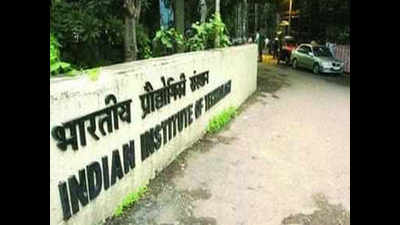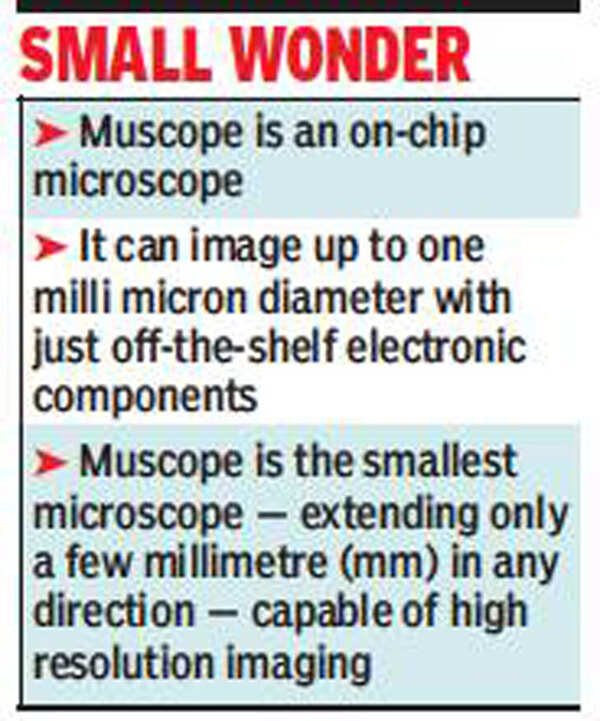- News
- City News
- Hyderabad News
- IIT-Hyderabad designs world’s smallest microscope
Trending
This story is from June 14, 2021
IIT-Hyderabad designs world’s smallest microscope
Researchers from Indian Institute of Technology (IIT), Hyderabad on Sunday said they have developed Muscope, the world’s smallest microscope, that will help in unravelling the mysteries of the microscopic world, including blood cells and disease-causing pathogens.

Using a micro LED display, an IIT-H team designed and experimentally demonstrated the innovative technology
HYDERABAD: Researchers from Indian Institute of Technology (IIT), Hyderabad on Sunday said they have developed Muscope, the world’s smallest microscope, that will help in unravelling the mysteries of the microscopic world, including blood cells and disease-causing pathogens.
Using a micro LED display, an IIT-H team designed and experimentally demonstrated the innovative technology.

Muscope is an on-chip microscope. It can image up to one milli micron diameter with off-the-shelf electronic components, without optimisation. It is the smallest microscope — extending a few millimetre — capable of high resolution imaging.
The IIT-H team that designed Muscope comprises Ekta Prajapati, Saurav Kumar, and Shishir Kumar of the department of electrical engineering. The result of the research study was published in preprint online portal, BioRxiv.
Shishir Kumar told TOI that Muscope is the smallest microscope in the world with resolution rivalling desktop microscopes. “We want to use it for integrating microscopes in devices for medical diagnostics and life science research. In these applications, addition of Muscope will make devices compact, low cost and automated. Consider for example, microfluidic chips that we are working on in our lab. We want to manipulate single cells in these chips, moving them around, dosing them with chemicals and observing them under various conditions. These chips are less than a milimetre thick and laid out on a glass slide,” he said.
Stating that to observe cells on these chips, a desktop microscope is quite troublesome as it occupies a large space, whose environment is hard to control, Shishir Kumar said that to observe multiple locations one has to have some mechanism to move either the chip or the microscope. The microscope itself is the costliest and most fragile part of the system.
“With Muscope, we can observe multiple locations by just adding multiple units of Muscope. Even with multiple Muscopes, the system will have the size of a mobile phone, costing a fraction of the desktop microscope. Muscope achieves these feats by using a newly developed light source. It is lensless and completely electronic, meaning that it is made only using electronic chips. Due to the special light source, Muscope has many additional advantages, including high-speed illumination and patterned/coded illumination. This allows implementation of various imaging modes,” he said.
The existing lensless microscopes can offer high resolution and wide field-of-view using super-resolution and computational techniques. But, the employment of macroscopic illumination system and unscalable opto-mechanical components limit their cost effectiveness, scalability, mass production and on-chip integration. Muscope fixes these issues.
Using a micro LED display, an IIT-H team designed and experimentally demonstrated the innovative technology.

Muscope is an on-chip microscope. It can image up to one milli micron diameter with off-the-shelf electronic components, without optimisation. It is the smallest microscope — extending a few millimetre — capable of high resolution imaging.
It has no purely optical or mechanical components and can be assembled like a circuit board. All its operations can be done over electrical interfaces. It can be software controlled — locally or remotely — and can be tuned online. Also, because of its small size, multiple Muscopes can be embedded in a small area, and in theory, their sizes can be tuned according to the desired field-of-view. Muscope uses common off the shelf components, making it low cost and robust.
The IIT-H team that designed Muscope comprises Ekta Prajapati, Saurav Kumar, and Shishir Kumar of the department of electrical engineering. The result of the research study was published in preprint online portal, BioRxiv.
Shishir Kumar told TOI that Muscope is the smallest microscope in the world with resolution rivalling desktop microscopes. “We want to use it for integrating microscopes in devices for medical diagnostics and life science research. In these applications, addition of Muscope will make devices compact, low cost and automated. Consider for example, microfluidic chips that we are working on in our lab. We want to manipulate single cells in these chips, moving them around, dosing them with chemicals and observing them under various conditions. These chips are less than a milimetre thick and laid out on a glass slide,” he said.
Stating that to observe cells on these chips, a desktop microscope is quite troublesome as it occupies a large space, whose environment is hard to control, Shishir Kumar said that to observe multiple locations one has to have some mechanism to move either the chip or the microscope. The microscope itself is the costliest and most fragile part of the system.
“With Muscope, we can observe multiple locations by just adding multiple units of Muscope. Even with multiple Muscopes, the system will have the size of a mobile phone, costing a fraction of the desktop microscope. Muscope achieves these feats by using a newly developed light source. It is lensless and completely electronic, meaning that it is made only using electronic chips. Due to the special light source, Muscope has many additional advantages, including high-speed illumination and patterned/coded illumination. This allows implementation of various imaging modes,” he said.
The existing lensless microscopes can offer high resolution and wide field-of-view using super-resolution and computational techniques. But, the employment of macroscopic illumination system and unscalable opto-mechanical components limit their cost effectiveness, scalability, mass production and on-chip integration. Muscope fixes these issues.
End of Article
FOLLOW US ON SOCIAL MEDIA










